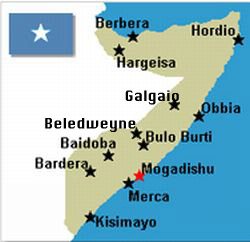A Personal Account, Part One
by Marc Wentling
Preface.
As hard as I try not to, I cannot help but think of Somalia when this time of year arrives. It was in October 1993 when an U.S. Black Hawk helicopter tumbled out of the sky, sparking the start of the biggest battle in Africa since World War II. Anyone who was in Mogadishu on that fateful day is burdened with an indelible memory of this bloody battle. I certainly cannot forget what I heard and observed first-hand in those days, especially as there are now daily news reports on the current famine in Somalia. While the world decides again what to do about the suffering occurring in Somalia, I thought maybe the time has come for me to relieve myself of my own account of what I experience in Somalia in 1993-94. I warn the reader that what is written in the following is done in a way that reflects the anarchy and chaos that prevailed as we worked back then to tame Somalia and save its people from famine and war.

My first upcountry trip in Somalia as USAID’s Mission Director in March 1993 marked me for life. We landed next to a remote camp for displaced people and, as soon as I stepped off our helicopter, my senses were overwhelmed by sights and smells that I had not come across during my previous 22 years of working with USAID and the Peace Corps in Africa. Thousands of emaciated people dressed in the barest rags were milling about as they waited for the food, water and medicines they needed to survive another day. I felt nauseous when I realized that we had arrived too late to fulfill our mission of saving the lives of many of these desperate people.
As the dust cleared and the swarms of flies left my eyes alone for a moment, I caught a glimpse of hundreds of small mounds of earth running in lines from the outskirts of the camp up to horizon. At first, it reminded me of the mounds farmers build in West Africa to plant yams. Then, it hit me like a low blow that these were the shallow graves of those who had already died and the pervading stench was that of decomposing bodies. I began to choke up and found it hard to breathe. The hellish scene of human misery was more than I could handle and the memory of it still haunts me.
As I wound my way back through the heaps of people to our helicopter, trying hard to not step on any of the dead or dying, I was not prepared for what I saw next. Blocking our passage was a line of about 20 young girls who were walking hand-in-hand in an awkward fashion. I could see that their ankles had been tied loosely together with a short length of rope and that they were guided by an older woman holding a long stick.
My first thought was that they were some kind of indentured servants, or girls promised in marriage, so they were tied like that to keep them from running away. I was disgusted to learn later that these were girls who had just been excised and their legs were tied to prevent them from taking big steps that would open their fresh genital wounds. Seeing the insistence on practicing this barbaric custom of female genital mutilation in such a horrific setting added anger to the deep anguish over what I saw on this unforgettable day.
Our helicopter took us on to the nearest town to check on the food supply situation. We found many hungry people but, to our dismay, we also found people who had more food than they could consume. It became obvious to us that the warlords and local leaders of the dominant clan controlled the reception and distribution of food aid. These elites would feed their goats and sheep before providing food to groups composed of lower social classes, usually descendents of former serfs and slaves. Seeing long-grain U.S. rice used to fatten the sheep of the elites while a large segment of the population went hungry was more than upsetting. Sadly, there was little that could be done in such an insecure environment to circumvent the power of the local elites, who never went hungry and often profited from Somalia’s misery.
It was hard to believe that only a few days earlier I had violated almost all security rules by arriving for the first time in Mogadishu (“Mog”) at night in a small, four-seater plane chartered by an international NGO. We got a late start from Wilson Airport in Nairobi because Kenyan customs officials wanted a “tip” before allowing us to take off with our emergency supply of medicines for Somalia. After a three-hour delay, and heated arguments with customs officials, we took off on our 90-minute flight to Mogadishu. This would be the first flight of over a dozen for me on this route, but it would be my only night flight.
The Mogadishu Airport was then one of the busiest and most chaotic airports in the world. Planes and helicopters of all sizes and shapes with pilots of many different nationalities were scattered across the tarmac, along with wrecked MIGS and other aircraft left behind from previous Somali wars. I did not know then that I would spend most of my time during my 13 months in Somalia in a wide variety of aircraft, visiting every corner of Somalia (I could write a story on each of these corners). I spent most of my time outside of Mog, as insecurity in that ruined city restricted movement. Of course, we were routinely evacuated to Nairobi when things got too “hot” in Mog.
I carried some things with me on the plane that I had not seen before for which there was a high demand at our mission in Mog. I am referring to three laptops. Later, I was to find that laptops were very useful to keep up with my report writing on my many plane rides. I also had my small cardboard suitcase that I bought in the street market in Nairobi and filled with my oldest clothes. You did not want to take anything of value with you into Somalia, plus the water in Mogadishu was so hard that after only a few washes your clothes were ruined. You learned to keep a stiff wire or ice pick in your bathroom to unblock the calcium deposits in your shower head.
 Also on the plane with me was one other passenger, a 22-year old white guy from Nairobi who excitedly told me how he was making a small fortune taking photos in Mog and turning them into postcards to sell to the thousands of foreign troops. He was proud that he was well-known among Somalis and could move freely about Mog. He said Mog was really not as dangerous as people said. Much later, I learned that he (Dan Eldon) along with two journalists had been clubbed and stoned to death in the street by a mob of Somalis infuriated by the wrongful bombing by U.S. forces of a suspected warlord meeting place. Dan was buried in a well-publicized funeral in Nairobi and a memorial fund was set up in his honor.
Also on the plane with me was one other passenger, a 22-year old white guy from Nairobi who excitedly told me how he was making a small fortune taking photos in Mog and turning them into postcards to sell to the thousands of foreign troops. He was proud that he was well-known among Somalis and could move freely about Mog. He said Mog was really not as dangerous as people said. Much later, I learned that he (Dan Eldon) along with two journalists had been clubbed and stoned to death in the street by a mob of Somalis infuriated by the wrongful bombing by U.S. forces of a suspected warlord meeting place. Dan was buried in a well-publicized funeral in Nairobi and a memorial fund was set up in his honor.
There were many casualties in Mog, but it was the death of another 22-year old that affected me the most. Kai Lincoln, an American, recent college graduate was doing an internship with the UN. One of his main duties was be to introduce the daily UN briefing. He basically said the same thing every day but he was highly committed to doing his best and a very likeable guy. He contrasted with the sloppy, overweight French soldier who gave the local weather report, which was invariably the same, i.e. “it is hot in Mog.” After a while, it was hard not to laugh when “Frenchy” appeared.
Frenchy was a slob, always unkempt but very funny. It was hard to understand how he could still be in uniform, but many of those sent to Somalia were misfits and huge miscasts. Many people were working in Somalia because they were not accepted for assignment elsewhere or they were after a fast promotion. It was hard to get really competent people to come to Somalia and, sometimes, the most able people did not last long. And those who stuck around would often develop a “care-free” attitude that made it harder to get them to work. Basically, they didn’t care because what more could be done to them than had already been done by being assigned to Somalia, the most dangerous work environment in the world at the time. And, of course, they thought it was pointless to do any work as they believed the situation in Somalia was hopeless. So much for the theme of “Restore Hope” that we all worked under.
Many times I felt we were dealt a losing hand from the beginning and — on our three-yard line needing the A-team — we were lucky to get the B-Team. Of course, in hindsight, it would have taken much more than a 100% A-Team and a couple generations of solid and wise occupation to make some progress in re-engineering the untamable Somalia. Furthermore, how much could you expect to achieve in a one-year assignment?. But, who would risk life and sanity by staying more than a year? It was something like a reverse “Catch-22” where all the characters in “Catch-22” had their counterparts in Somalia.
The very dedicated Kai lived in the UN housing compound that was located a short distance outside the UN headquarters that had been established on the former U.S. Embassy grounds that had been abandoned in 1991, shortly after this first very expensive Inman Embassy facility* had been constructed. (These grounds could be the site of the most invested earth in Africa.) Early every morning Kai joined others to take the convoy of heavily protected vehicles to his office. On November 13, 1993, he was late, missed his convoy, and asked a UN security officer to help him catch up with the convoy. Their car had gone a short distance when it was ambushed by hijackers. Kai was badly wounded and bled to death in the street. One other person in the car was also killed.

Mark G. Wentling spent nine years with the Peace Corps (Honduras, 1967-69; Togo, 1970-73; Peace Corps Staff, Togo, Gabon and Niger, 1973-76) before joining USAID in 1977. As a U.S. Foreign Service Officer he served in Niamey, Conakry, Lome, Mogadishu, Dar es Salaam and Washington, D.C before retiring from the Senior Foreign Service in 1996. Since his retirement he has worked for USAID as it Senior Advisor for the Great Lakes and Country Program Manager for Niger and Burkina Faso. He is a 1992 National War College Graduate. He has also worked in Africa for U.S. Non-Governmental Organizations and he is currently Country Director for Plan in Burkina Faso. On September 20, he marked 41 years since arriving in Africa in 1970. He has worked in, or visited, 53 African countries.
